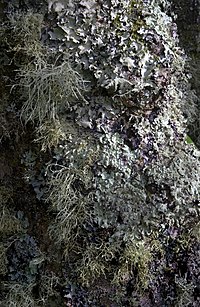
Photo from wikipedia
The fungal holobiont: evidence from early diverging fungi Laila P. Partida-Martínez Departamento de Ingeniería Genética, Centro de Investigación y de Estudios Avanzados del IPN, Irapuato 36821, Gto., México. E-mail: [email protected]… Click to show full abstract
The fungal holobiont: evidence from early diverging fungi Laila P. Partida-Martínez Departamento de Ingeniería Genética, Centro de Investigación y de Estudios Avanzados del IPN, Irapuato 36821, Gto., México. E-mail: [email protected] The endosymbiosis of bacteria is a hallmark in the evolution of eukaryotic cells and it is not limited to the origin of mitochondria and chloroplasts (Margulis, 1991). Microbial symbionts contribute to the fitness, development and evolution of eukaryotic hosts. Thus, eukaryotes can not longer be considered individual entities, but rather holobionts (host plus microbial symbionts) with an hologenome (host + organelles + microbial genomes) in which evolutionary processes act (Bordenstein and Theis, 2015; Rosenberg and Zilber-Rosenberg, 2016). The term holobiont and hologenome has been mostly used in animals and plants (Rosenberg et al., 2007; Vandenkoornhuyse et al., 2015), but as we will highlight here, the investigations by Uehling et al., and Li et al., published now in Environmental Microbiology, together with the advances in the field, demonstrate that fungi can also be considered holobionts. Evidence 1: Fungi contain diverse and abundant microbiota Fungi and bacteria co-inhabit most environments of the planet. However, we just recently began to appreciate how their interaction influence each other and the ecosystems in which they develop (FreyKlett et al., 2011). In the new millennium, bacterial symbionts thriving inside fungi had been identified in several fungal lineages expanding from the recently proposed taxonomic phylum Mucoromycota (Spatafora et al., 2016), which includes subphyla Glomeromycotina, Mucoromycotina and Mortierellomycotina, to the Ascomycota and Basidiomycota (Bianciotto et al., 1996; Partida-Martinez and Hertweck, 2005; Sharma et al., 2008; Sato et al., 2010; Naumann et al., 2010; Hoffman and Arnold, 2010; Desirò et al., 2014, 2015; Ruiz-Herrera et al., 2015).
Journal Title: Environmental microbiology
Year Published: 2017
Link to full text (if available)
Share on Social Media: Sign Up to like & get
recommendations!